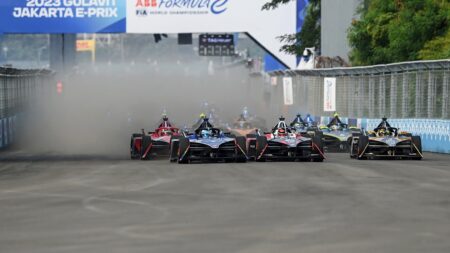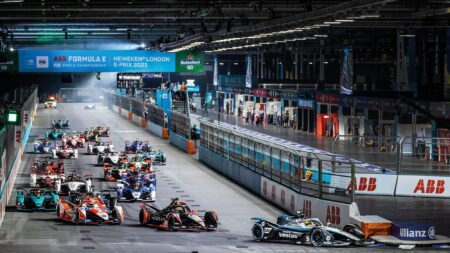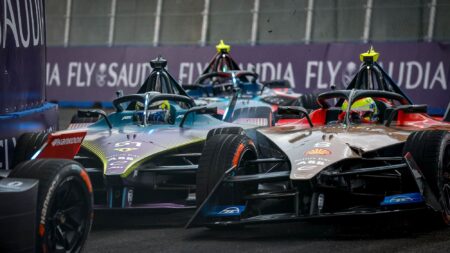
How Oliver Rowland can become Britain's next World Champion
Nissan’s Oliver Rowland could clinch his first drivers’ world championship title this weekend, here is all you need to know about the Yorkshireman competing in Formula E
Jaguar has announced that it will enter the FIA Formula E Championship next season, heralding a return to motor sport after more than a decade away. The last time a current Jag graced a circuit it was with Mark Webber and Christian Klien in the 2004 Formula 1 World Championship. It wasn’t a huge success. The new entry into Formula E, though, has plenty of promise. It’s teaming up with Williams Advanced Engineering – Jaguar’s C-X75 hybrid supercar was built with WAE – to help with the project and it has 8000 engineers on hand to tackle the many problems which will arise.
At the announcement on Tuesday there was lots of talk of Jaguar Land Rover being all about “pioneering technology”, of “firmly believing electrification is the future” and how radical change is needed to meet the 2020 carbon targets. JLR also talked of its brand new range of fully electric vehicles and how Formula E was a perfect fit.
So why Formula E and not Formula 1 or the World Endurance Championship? The replies from Jaguar’s future team director James Barclay should be a warning shot across Formula 1’s bows. “The championship is a perfect fit for us,” said Barclay. “It’s innovative, it’s exciting and future facing. It brings racing to the heart of city centres and it has a very young appeal. That’s very important to us. It’s very much a next generation activity and the team at Formula E has also been very innovative in terms of how they approach their digital marketing. It also has a very clever cost cap and it creates a championship that we know will be focused on the performance and innovation.”
I don’t think Barclay was directly attacking F1, but the message was clear to the powers-that-be in the sport’s top echelon: Formula E is a more attractive prospect to a lot of manufacturers right now.
The proof is in the entry list for next season when Audi, Renault, Mahindra, Citroën and Jaguar will all be on the grid (while they will manufacture their own powertrains I haven’t included Dragon). What’s more, another manufacturer will be announced before this season’s end.
So who else might join? BMW? FIAT? Alfa Romeo? Ford maybe? Nissan? I got in touch with as many manufacturers as possible to ask their views on Formula E and while some didn’t reply, others openly admitted to watching the all-electric championship carefully.
Here are the replies:
Ford, Vauxhall, Suzuki: “watching with interest, but no plans to enter”.
Peugeot, Volkswagen: A sister brand already competes. (VW has a technical tie up with ABT.)
Mazda, Toyota: “no current interest”.
FIAT/Alfa Romeo: “genuinely no interest”.
Hyundai/Kia: “We are working on electric technology and Kia has ambitions in the electronic world, but at this point in time there is no Formula E project because Hyundai is in the WRC where they have unfinished business. We won’t look at anything until they are competitive in the WRC.”
MG: “Not something we’re looking to do. We’ve just announced another three years in the BTCC and that’s what we’re focussing on”.
Maserati: “The formula E format makes for interesting racing and, as the audience grows, it becomes a more interesting communication stream. Without pure battery-powered propulsion systems currently available within Maserati products, though, the link to such racing programmes is less relevant for us today.”
Bentley: “Concentrating on our GT3 programme”.
Skoda: “We’ve had our eyes on Formula E and it’s a really interesting competition. However, we are now fully focusing on rallying and our new Fabia R5.”
Volvo: “We do not have a formal position on Formula E as we haven’t been approached about involvement. Like other brands, electrification is an important part of our future product strategy.”
Interestingly, one of the brands which didn’t get back to me was BMW. One that’s perhaps near the top of the list when it comes to the next mystery manufacturer entry.
Formula E will not be a replacement for Formula 1. However, it’s easy to see why it’s attracting so much manufacturer interest. There are a range of powertrains on the grid at the moment with the likes of Nextev TCR, DS Virgin Racing and Renault all going for a twin-motor solution while others have gone for a single motor. Gearboxes also vary from one gear to five and the aim is to do away with the car swapping by the 2018/19 season. It’s a refreshing mix of different solutions. It’s just sad that all the cars look the same so that the differing powertrains aren’t evident to the spectators.
You may wonder how much all this development has/will cost. There are rumours of some spending £5.8m on powertrains, but because of tight regulations and a cap on power this is not the norm. Even so, budgets for a full season of racing won’t be much higher than £10m. It’s a far cry from F1’s £250m. Formula E has also kept spending in check by limiting test days, banning aero development and making sure the meetings are all one-day affairs. The key thing is that the budget for a season’s racing can easily put into manufacturers’ R&D, like JLR is doing.
Consider, for a moment, that Jaguar Land Rover sold 500,000 vehicles in 2015, that they employ 40,000 people and that they invested £11 billion in products and facilities over the last five years. If you were creating a new line up of electric cars could you afford not to be in Formula E?
Formula E CEO Alejandro Agag couldn’t make the Jaguar launch because of the race this weekend, but left a video message in which he said “At the start, if someone told me that Jaguar would come in I wouldn’t have believed them”. I’m sure he wouldn’t have. And I doubt he would have believed someone if they said there would be six manufacturers on the grid in the series’ third season.
Love Formula E or loathe it, you must appreciate its relevance and its different approach. Is it the future of motor sport? No, but it’s a part of the future and it needs to be taken seriously.

Nissan’s Oliver Rowland could clinch his first drivers’ world championship title this weekend, here is all you need to know about the Yorkshireman competing in Formula E

As Formula E enters its tenth season, it's still seen with scepticism by racing fans. But as coverage switches to pay TV, it is now worth watching, says Damien Smith

14 races. Three continents. Seven months in the making. It all comes down to one thrilling finale. Season nine of the Formula E world championship is officially coming to a…

Formula E is leading the way out of FIA world championships for the best racing action this season – but will fans pay attention?